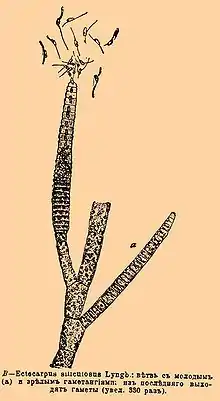Ectocarpus siliculosus
Ectocarpus siliculosus is a filamentous brown alga.[1] Its genome was the first brown macroalgal genome to be sequenced,[2] with the expectation that E. siliculosus will serve as a genetic and genomic model for brown macroalgae.[3]
| Ectocarpus siliculosus | |
|---|---|
 | |
| E. siliculosus, from the Brockhaus and Efron Encyclopedic Dictionary (1890-1907) | |
| Scientific classification | |
| Clade: | SAR |
| Phylum: | Ochrophyta |
| Class: | Phaeophyceae |
| Order: | Ectocarpales |
| Family: | Ectocarpaceae |
| Genus: | Ectocarpus |
| Species: | E. siliculosus |
| Binomial name | |
| Ectocarpus siliculosus | |
The alga is unbranched and filamentous; it forms soft beards on larger plants or other firm substrata and grows up to 2 feet long.[4]
Plants tufted, often only one to a few cm tall, but in exceptional cases up to 20 cm. Axes freely branched, main axis not distinguishable. Filaments up to 30μm in diameter, tapering toward the apices. sometimes forming terminal pseudohairs. Distribution: Cosmopolitan.[5]
This species ofEctocarpus has been shown to bind iron on its cells with non-specificity. This iron ion shell allows the algae to store and have a constant source of iron regardless of the conditions of the surrounding environment. This adaptation is important because this method of iron uptake is similar to that of terrestrial organisms and differs from the methods typically used in the marine environment such as siderophores.[6]
References
- Charrier, B; Coelho, SM; Le Bail, A; Tonon, T; Michel, G; Potin, P; Kloareg, B; Boyen, C; et al. (2008). "Development and physiology of the brown alga Ectocarpus siliculosus: two centuries of research" (PDF). The New Phytologist. 177 (2): 319–32. doi:10.1111/j.1469-8137.2007.02304.x. PMID 18181960.
- Cock, J. M.; Sterck, L.; Rouzé, P.; Scornet, D.; Allen, A. E.; Amoutzias, G.; Anthouard, V.; Artiguenave, F. O.; Aury, J. M.; Badger, J. H.; Beszteri, B.; Billiau, K.; Bonnet, E.; Bothwell, J. H.; Bowler, C.; Boyen, C.; Brownlee, C.; Carrano, C. J.; Charrier, B. N. D.; Cho, G. Y.; Coelho, S. M.; Collén, J.; Corre, E.; Da Silva, C.; Delage, L.; Delaroque, N.; Dittami, S. M.; Doulbeau, S.; Elias, M.; Farnham, G. (2010). "The Ectocarpus genome and the independent evolution of multicellularity in brown algae" (PDF). Nature. 465 (7298): 617–621. Bibcode:2010Natur.465..617C. doi:10.1038/nature09016. PMID 20520714.
- Genoscope - Ectocarpus genome project at genoscope
- Gosner, Kenneth L., Atlantic Seashore: A field guide to sponges, jellyfish, sea urchins, and more; Houghton Mifflin Co.
- Stegenga, H. Bolton, J.J. and Anderson, R.J. Seaweeds of the South African West Coast; Contributions from the Bolus Herbarium Number 18, 1997.
- "Ectocarpus". Ectocarpus. Retrieved 2016-04-19.
Further reading
Prigent, Sylvain; Collet, Guillaume; Dittami, Simon M. (27 August 2014). "The genome-scale metabolic network of Ectocarpus siliculosus (EctoGEM): a resource to study brown algal physiology and beyond". Plant Journal. 80 (2): 367–381. doi:10.1111/tpj.12627. PMID 25065645.